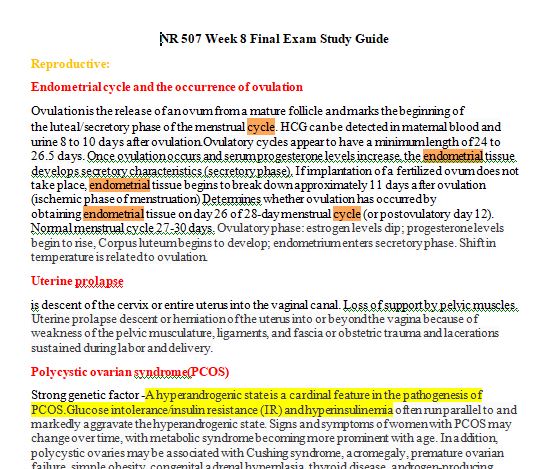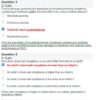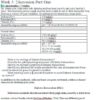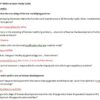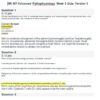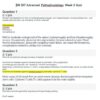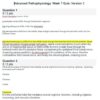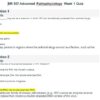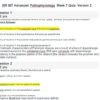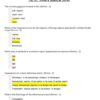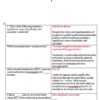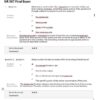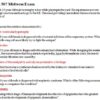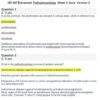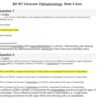Description
NR 507 Final Exam Week 8 Study Guide
Reproductive:
- Endometrial cycle and the occurrence of ovulation
- Uterine prolapse
- Polycystic ovarian syndrome(PCOS)
- Testicular cancer and conditions that increase risk:
- Symptoms that require evaluation for breast cancer
- Signs of premenstrual dysphoric disorder
- Dysfunctional uterine bleeding(DUB)
- athophysiology of prostate cancer
- HPV and the development of cervical cancer
Endocrine:
- Body’s process for adapting to high hormone levels
- Cushing’s Syndrome
- Causes of hypoparathyroidism
- Lab results that point to primary hypothyroidism
- Pathophysiology of thyroid storm
- Signs of thyrotoxicosis
Neurological:
- Dermatomes
- substance release at the synapse
- Spondylolysis
- Location of the motor and sensory areas of the brain
- Pathophysiology of cerebral infarction and excitotoxins
- Agnosia
- Accumulation of blood in a subarachnoid hemorrhage
- Most common cause of meningitis
Genitourinary:
- Diet and the prevention of prostate cancer
- Impact of Benign Prostatic Hypertrophy (BPH) on the urinary system
Genetics:
- The role of DNA in genetics
- Transcription
- Effects of genetic mutations
- Trisomy
- Down Syndrome
- Klinefelter syndrome
- Diseases that have multifactorial traits
- Multifactorial inheritance
- Duchenne muscular dystrophy
- Neurofibromatosis
Musculoskeletal:
- Ions that initiate muscle contraction
- Growth of long bones in children
- bones belonging to the appendicular skeleton
Immunity/Inflammation:
- How vaccines are formed
- Populations at risk for getting systemic fungal infections and parasitic infections
- Systemic manifestations of infection
- Mechanisms responsible for the increase in antimicrobial resistance worldwide
- Functions of normal flora in the body
- Desensitization Therapy
- Cells involved in “left shift” in the WBC count differential
- Forms of immunity
- Major histocompatibility class I antigens
- Inflammatory chemicals blocked by anti-inflammatory drug
- Characteristics of acute phase reactant C-reactive protein
Dermatology:
- Process by which a deep pressure ulcer heals
- Complications of the development of contractures during wound healing
Acid/Base:
- Causes of respiratory alkalosis
- Molecules that act as buffers in the blood
Cardiovascular:
- Most common cardiac valve disease in women
- When myocardial ischemia may be reversible
- Symptoms of stable angina
- Orthostatic hypotension
- Isolated systolic hypertension
- Results of sustained controlled hypertension
- The relationship of insulin resistance on the development of primary hypertension
- Defects in the normal secretion of natriuretic hormones and the impact on renal system
- Effects of increased sympathetic nervous system activity due to primary hypertension
- Complications of unstable plaque in the coronary arteries
- Forms of dyslipidemia associated with the development of the fatty streak in atherosclerosis
- Events that initiate the process of atherosclerosis
- Signs and symptoms of increased left atrial and pulmonary venous pressures in left sided heart failure
- Differences between left and right sided heart failure
- Infective endocarditis
Peripheral vascular disease:
- Pathophysiology of deep vein thrombosis
- Vichow’s triad
Hematology:
- Physiological response to hypoxia in anemia
- Populations at the highest risk for developing folate deficiency anemia
- Causes of iron deficiency anemia
- Expected lab test results found in long standing iron deficiency anemia
- Sickle Cell Anemia
- Causes of aplastic anemia nr 507 final exam
- Underlying pathophysiologic mechanisms leading to autoimmune hemolytic anemia
- Secondary polycythemia
- Anemia of chronic renal failure
Fluid and Electrolytes:
- Conditions that result in pure water deficit (hypertonic volume depletion)
- Osmoreceptors that stimulate thirst and the release of ADH
- Causes of hypernatremia
- Effects of increased aldosterone
- Dependent edema
- Definition of isotonic
- Principle of capillary oncotic pressure
- Types of fluid compartments in the body
